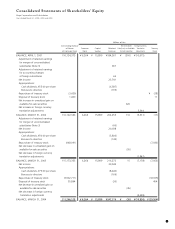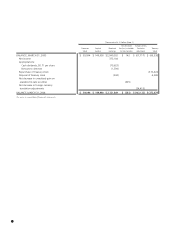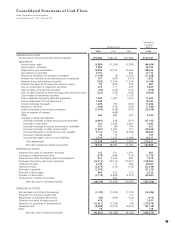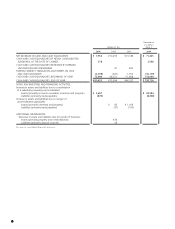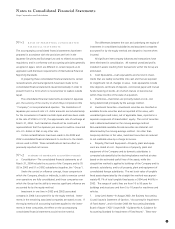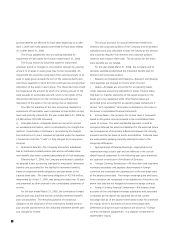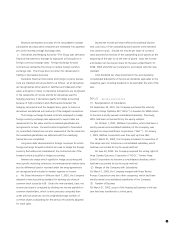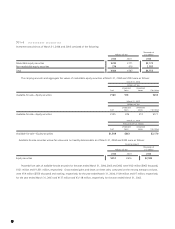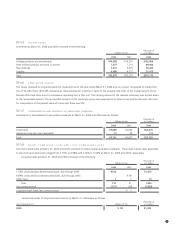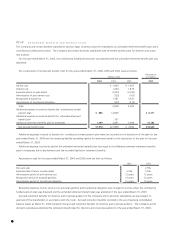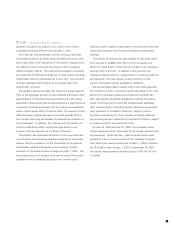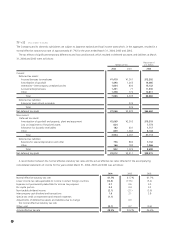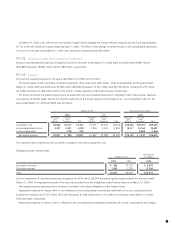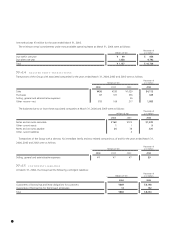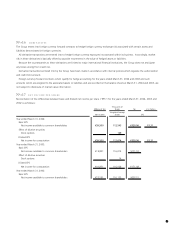Pentax 2004 Annual Report Download - page 51
Download and view the complete annual report
Please find page 51 of the 2004 Pentax annual report below. You can navigate through the pages in the report by either clicking on the pages listed below, or by using the keyword search tool below to find specific information within the annual report.
49
No»1BASIS OF PRESENTING CONSOLIDATED
FINANCIAL STATEMENTS
The accompanying consolidated financial statements have been
prepared in accordance with the provisions set forth in the
Japanese Securities and Exchange Law and its related accounting
regulations, and in conformity with accounting principles generally
accepted in Japan, which are different in certain respects as to
application and disclosure requirements of International Financial
Reporting Standards.
In preparing these consolidated financial statements, certain
reclassifications and rearrangements have been made to the
consolidated financial statements issued domestically in order to
present them in a form which is more familiar to readers outside
Japan.
The consolidated financial statements are stated in Japanese
yen, the currency of the country in which Hoya Corporation (the
"Company") is incorporated and operates. The translations of
Japanese yen amounts into U.S. dollar amounts are included solely
for the convenience of readers outside Japan and have been made
at the rate of ¥106 to U.S.$1, the approximate rate of exchange at
March 31, 2004. Such translation should not be construed as
representations that the Japanese yen amounts could be converted
into U.S. dollars at that or any other rate.
Certain reclassifications have been made in the 2003 and
2002 consolidated financial statements to conform to the classifi-
cations used in 2004. These reclassifications had no effect on
previously reported net income.
No»2SUMMARY OF SIGNIFICANT ACCOUNTING POLICIES
a. Consolidation—The consolidated financial statements as of
March 31, 2004 include the accounts of the Company and its 55
(52 in 2003 and 51 in 2002) subsidiaries (together, the "Group").
Under the control or influence concept, those companies in
which the Company, directly or indirectly, is able to exercise control
over operations are fully consolidated, and those companies over
which the Group has the ability to exercise significant influence are
accounted for by the equity method.
Investment in one (two in 2003 and 2002) associated
company in 2004 is accounted for by the equity method. Invest-
ments in the remaining associated companies are stated at cost. If
the equity method of accounting had been applied to the invest-
ments in these companies, the effect on the accompanying
consolidated financial statements would not be material.
The differences between the cost and underlying net equity of
investment in consolidated subsidiaries and associated companies
accounted for by the equity method are charged to income when
incurred.
All significant intercompany balances and transactions have
been eliminated in consolidation. All material unrealized profits
included in assets resulting from transactions within the Group are
eliminated.
b. Cash Equivalents—Cash equivalents are short-term invest-
ments that are readily convertible into cash and that are exposed
to insignificant risk of changes in value. Cash equivalents include
time deposits, certificate of deposits, commercial paper and mutual
funds investing in bonds, all of which mature or become due
within three months of the date of acquisition.
c. Inventories—Inventories are primarily stated at cost, cost
being determined principally by the average method.
d. Investment Securities—Investment securities are classified as
available-for-sale securities and are reported at fair value, with
unrealized gains and losses, net of applicable taxes, reported in a
separate component of shareholders' equity. The cost of securities
sold is determined based on the moving-average method.
Non-marketable available-for-sale securities are stated at cost
determined by the moving-average method. For other than
temporary declines in fair value, investment securities are reduced
to net realizable value by a charge to income.
e. Property, Plant and Equipment—Property, plant and equip-
ment are stated at cost. Depreciation of property, plant and
equipment of the Company and its domestic subsidiaries is
computed substantially by the declining-balance method at rates
based on the estimated useful lives of the assets, while the
straight-line method is applied to buildings of the Company and its
domestic subsidiaries, and to all property, plant and equipment of
consolidated foreign subsidiaries. The net book value of tangible
fixed assets depreciated by the straight-line method was approxi-
mately 45.1% of total tangible fixed assets in 2004 and 44.6% in
2003. The ranges of useful lives are from 10 to 50 years for
buildings and structures and from 5 to 10 years for machinery and
vehicles.
f. Long-Lived Assets—In August 2002, the Business Accounting
Council issued a Statement of Opinion, "Accounting for Impairment
of Fixed Assets", and in October 2003 the Accounting Standards
Board of Japan ("ASB") issued ASB "Guidance No.6, Guidance for
Accounting Standard for Impairment of Fixed Assets". These new
Notes to Consolidated Financial Statements
Hoya Corporation and Subsidiaries








